May Day concert of Narvan Soittokunta
| May Day concert of Narvan Soittokunta | ||||
|---|---|---|---|---|
|
Practitioners and people who know the tradition well
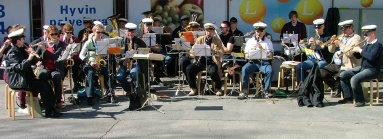
The power of music stems from traditions built over centuries or even millennia, such as old compositions and various music-related events. This article is about one small tradition which was born in the early 20th century: the May Day concert played by the Narvan Soittokunta wind orchestra based in Vesilahti. In the olden days, May Day celebrations involved all manner of spells, and one such spell is connected to the concert tradition in question.
Narvan Soittokunta was originally a brass septet with male musicians only. In the 1970s, young boys and girls from the entire Vesilahti region got involved. With the new players, the range of instruments expanded and the ensemble became a contemporary brass band. These days, the band’s musicians are mainly from Vesilahti, but there are some members from nearby municipalities as well. All kinds of professions and demographics have always been represented. The audiences of the May Day concert primarily come from the Narva area and nearby villages, but if the weather is favourable, people may travel to the event across long distances. On May Day in 2008, a band and dance group from Germany also took part in the concert.
Practising of the tradition
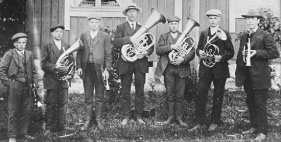
Narvan Soittokunta’s May Day concert is held near the shops and market place in the centre of Narva on 1 May from 11 am to 12 noon. If the weather is particularly poor, the event is moved to the community hall. In recent years, the ensemble has included 20–30 musicians. When the septet grew into a wind orchestra in the 1970s, the line-up was supplemented with flutes, clarinets, oboes, saxophones, trombones, French horns and a variety of percussion instruments. The old septet did not necessarily need a conductor, but one is required by the wind orchestra due to the wider range of musical works performed.
The orchestra’s repertoire is mainly decided by the players, but some staples are always included. The concert has presumably always begun with the Suvivirsi summertime hymn. The second piece has usually been another hymn or a song, followed by the march ‘Meidän poikain marssi’. There has been great variation in what follows next, but the final march has nearly always been ‘Muistoja Pohjolasta’. Since May Day is a workers’ celebration, the orchestra has always played a traditional workers’ march. The remainder of the concert has been constructed making sure that the pieces played in recent years are not repeated, with the exception of the staples that are always included.
In normal weather conditions, the May Day concert is played outside, which is why the pieces must also be selected accordingly. Common crowd-pleasers include wistful waltzes, tangos and folk songs, but there are also boisterous military marches. Still, the orchestra has tried not to limit itself to these and has sought to perform works by well-known master composers. The range of composers covered in the May Day concerts has included the likes of Sibelius, Beethoven, Grieg, Bartok, Brahms, Verdi, Tchaikovsky, Elgar, Mussorgsky, Chopin, Dvorak, Purcell and Strauss.
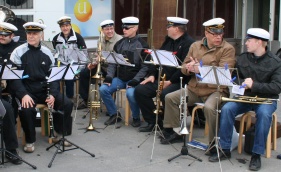
Brass players taking a break on May Day 2011. Listeners come to the concert if the weather permits and they happen to feel like it – at times there are only a few dozen listeners, while sometimes the crowd numbers in the hundreds. Although the concert is held every year and is advertised, it is very informal and unofficial: there are no seats and the audience can come and go as they please. A May Day market place has been set up in connection with the concert in recent years.
The background and history of the tradition
Music has been a prevalent pastime in Vesilahti since the 18th century, at least. At the time, the local music scene was also invigorated by the military musicians belonging to the Vesilahti Company of the Pori Regiment. They lived in Vesilahti and demonstrated their skills in a wide range of events. The most popular varieties were folk and dance music – some sheet music even survives to this day. Later, folk musicians were in demand for dances at small private celebrations as well.
No one remembers exactly when Narvan Soittokunta played its first May Day concert, but Alfred Söyrinki, who played the baritone horn in the 1910s, surmised that the concert tradition began between 1906 and 1908, which would make it more than a century old. The band was established by the teacher at the Narva School, Sefanias Tiensuu (1871-1962), who began training village residents to play as a septet in the autumn of 1904. In a couple of years, the teacher’s position was taken up by Akseli Nopola, who led the band for 30 years alongside his other duties.
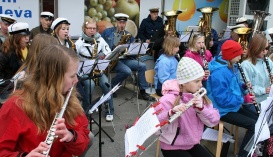
The brass bands of the time were based on the tradition of Prussian military orchestras. The tradition was brought to Finland in the 1870s and ‘80s by the Kaarti Battalion conductor Adolf Leander (1833–1899). A pure brass septet includes seven instruments: an E flat cornet, two B flat cornets, an alto horn, a tenor horn, a baritone horn and a tuba. The ensemble is often supplemented with additional instruments.
In accordance with the national romantic ideals of public enlightenment in the late 19th century, Finland began to set up organisations to promote cultural hobbies. Youth associations, workers’ unions, temperance organisations and Kansanvalistusseura (the Finnish Lifelong Learning Association) took it upon themselves to promote song and music in particular. The associations and their central organisations published septet scores and guide books, provided assistance for establishing bands and acquiring instruments, and organised large music festivals, one of which was held in the Narva village of Vesilahti in 1913. This resulted in a boom of brass septets that spanned the entire nation. In addition to the associations, septets were established by factories and fire brigades. Concert traditions were also established around the septet tradition.
Narvan Soittokunta was not the first brass septet in Vesilahti, as one had already been established in 1884. The driving force behind the ensemble was shopkeeper K.M. Grönfors. The band gradually faded away, however. In the 1920s, a band was also established in the Ylämäki area of Vesilahti, which served as a parade orchestra for the White Guard, for example. Later on, the Ylämäki septet operated in connection with Narvan Soittokunta.
May Day festivities cover many things, but originally the day involved singing and ringing cowbells in celebration of St Walpurga, a female missionary who lived in the Middle Ages. The beginning of May, being a critical time in terms of agriculture, was the obvious impetus to take any measures available to secure one’s livelihood in the summer season. At the end of the 19th century, the recent famine was still fresh in the minds of all Finns. Most likely, people in those days did not have a clear view of what actually affected weather conditions, the growth of crops, the well-being of livestock and good fish hauls. Even the message spread by Christianity may have been interpreted as indicating that it was possible to affect natural events by metaphysical means. So the question was, could magical methods lead to the desired end result? Most people probably thought it wise to at least try. The human voice and music were thought to have magical powers.
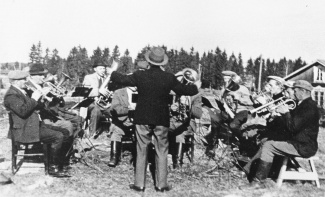
Their animals would be safe if only they remembered to blow into their goat horns on May Day morning. This was the belief, at least subconsciously, wherever you went. Johannes Heimometsä, a resident of Vesilahti born in 1903, recalled that farmers planting crops in springtime used to resort to many kinds of spells. For example, they would spit in all cardinal directions and chant ‘Lietso itä, lietso länsi, pohjoinen älä porota’ (‘Shine on East, shine on West – North, you can keep the rest’).
Apparently, the Narvan Soittokunta orchestra joined the spell tradition very early on. The purpose of the playing was to ensure crop growth and abundant hauls of fish in the coming summer. As a result, when a concert was played on May Day and the crops turned out to be good, it was easy to draw the conclusion that the spell had worked. But what about the times when no concert was held? On May Day morning in 1962, the weather was stormy and sleet fell from the sky, resulting in the musicians deciding to skip the concert. The year turned out dismal in many areas – crops rotted in the fields and fish were scarce. In peoples’ minds, the fault naturally fell on the band that had shirked their duties and neglected to play the concert! Ever since, locals have made sure that such outrageous negligence cannot happen. In poor weather, the band has played under a cover of some kind.
At first, the May Day concert was held on Tuulikallio, a hill next to Narva School, but once Tähtelä youth community centre was completed in 1908, the concert was relocated there. During the Civil War in 1918, nearly everything burnt down, which is why newly-built residential buildings were used for the concert. In the 1920s, the concert was held on top of Hurskasvuori, an age-old hilltop spot for burning ‘helavalkea’ bonfires, which had been stripped of trees by Russian fortress builders. From these locations, the sound could be heard from afar. In 1946, the concert was once again moved to Tuulikallio and in 1969 to the museum area nearby. As the orchestra grew, the May Day concert was moved to the market square that was formed in the village centre in the mid-1970s.
The transmission of the tradition
What are the factors that have kept Narvan Soittokunta and its May Day concert going for more than a century? Only the worst periods of war have prevented the otherwise regular concerts and performances. In addition to the May Day concert, the orchestra holds annual performances on national holidays, some of which have become traditions.
The traditional May Day concert also provides a good reason and opportunity to get together to commemorate a momentous occasion. Whatever the consensus may be on magical powers and spells, the performance itself constitutes an important framework for social interaction. Unfortunately, increased costs, reduced grants and tighter safety requirements have diminished opportunities to enjoy events of this kind. From the perspective of the orchestra, the concert ensures that they stay motivated to practise diligently. The event is also generally significant as a starting point for the summer season. Since in good weather there are often hundreds of listeners, the demand for the May Day concert is clearly there.
The tradition related to the Narva May Day concert has also survived due to the fact that the orchestra includes musicians of all ages. The youngest are sometimes under 10 years old and people over 70 have been involved almost throughout the ensemble’s entire life span. The playing tradition also persists across generational boundaries. At times, the orchestra has had players from two or even three generations simultaneously – fathers and mothers who play bring their children and grandchildren along. Descendants of the band’s original musicians have also been involved almost continuously.
The older musicians like to reminisce about eventful performances and mishaps from decades past. This has helped to maintain and strengthen the May Day tradition. Perhaps even the audiences like the opportunity to revisit old celebrations. The concerts are always unique if for no other reason than the fact that the weather around the beginning of May tends to be extremely erratic.
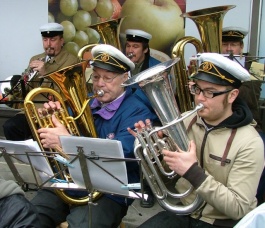
It is also important to maintain the tradition due to the skill range of the musicians being as vast as it is, ranging from novices to masters. Many of the players have developed their skills mainly in orchestras, which is why they are given slightly easier sheet music. Some of the musicians are trained professionals, who have shouldered the responsibility for educating the younger members both in terms of instrument-specific proficiency and the performance as a whole. In 2016, one of the players racked up 40 consecutive May Day concerts.
The future of the tradition
The May Day concert of the Narvan Soittokunta wind orchestra is a traditional event that enthusiastic audiences have been happy to attend for more than a century. This has encouraged the musicians to keep going. Since no tradition can be maintained by force of will alone, the concert must be important to the community. The event that may appear as nothing more than a fun little annual celebration to the outside observer is a long-awaited sign of the summer to both the players and the audience. It provides a good reason to get together and see friends and acquaintances. As such, it may continue to prevail despite distractions, such as television and social media, for a long time to come. The older players like to remind the younger generations to not let the star go out.
Another factor that is likely to influence the future of the concert is the fact that it is highly informal. The arrangements themselves and the bureaucracy involved are not a burden to the musicians or listeners. This has also ensured that the costs can be kept low. Nevertheless, the musicians take the concert very seriously and have strived to update their repertoire and skills to meet the increasing demands of the audiences.
On a slightly playful note, you could say that if the concert tradition were to be abolished, the fields would truly go barren, as abandoning the tradition could be seen as an indication of a severe lack of motivation and community spirit. The May Day concert can serve, at least in small part, as a reminder to maintain these important qualities and spark activity in the local community. Does that not mean that the spell is working?
The community/communities behind this submission.
NGO Narvan Tähti Nuorisoseura
Bibliography and links to external sources of information
Archives of Narvan Soittokunta and interviews with the musicians
Newspaper articles from Lempäälän-Vesilahden Sanomat of the concerts
Litterature
Haavisto Timo 2004. Sata vuotta narvalaista puhallinmusiikkia 1904-2004. Julkaisematon käsikirjoitus, 2004.
Karjalainen Kauko 1995. Suomalainen torviseitsikko. Historia ja perinteen jatkuminen. TYO:n Kansanperinteen laitoksen julk. 20, Tampereen Yliopiston Kansanperinteen laitos.
Nallinmaa Eero 1969. Erik Ulrik Spoofin nuottikirja, Tampere: omakustanne,väitöskirja.
Vilkuna Kustaa 1978. Vuotuinen ajantieto, Otava.
